There are two 2CD sets of the complete Mozart violin concertos this month, one of which is simply unique.
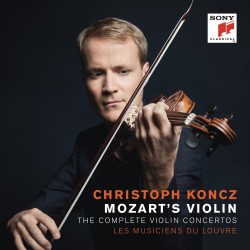 On Mozart’s Violin: The Complete Violin Concertos violinist Christoph Koncz and Les Musiciens du Louvre, one of Europe’s leading period-instrument ensembles perform the concertos with Koncz – astonishingly – playing Mozart’s own violin (Sony Classical G010004353645E sonyclassical.lnk.to/Koncz_MozartsViolinPR).
On Mozart’s Violin: The Complete Violin Concertos violinist Christoph Koncz and Les Musiciens du Louvre, one of Europe’s leading period-instrument ensembles perform the concertos with Koncz – astonishingly – playing Mozart’s own violin (Sony Classical G010004353645E sonyclassical.lnk.to/Koncz_MozartsViolinPR).
The violin, made in the early 1700s by Klotz of Mittenwald after a Jacob Steiner model, was played by Mozart while he was concertmaster in the Salzburg Hofkapelle from 1769. It was entrusted to his sister Maria Anna (Nannerl) when he moved to Vienna in 1781. The concertos date from 1773-75, so would have been played on this instrument; indeed, Koncz makes a strong case for the violin’s particular sound clearly influencing the compositions. The instrument passed through various owners – all listed in the booklet notes – before being acquired by the Salzburg Mozarteum Foundation in 1955. Remarkably, it has retained its original Baroque form, and not suffered any alterations.
Koncz clearly understood and appreciated the remarkable privilege accorded him by this recording project, and he responded with absolutely faultless performances. The violin has a sweet, clear sound, and Koncz plays it beautifully, with a tasteful use of vibrato and with warmth and feeling. Mozart left no cadenzas – these would have been improvised at the time – and Koncz supplies his own, after studying the extant cadenzas for the piano concertos and immersing himself in the style of Mozart’s Salzburg years. Les Musiciens du Louvre, the first ensemble to perform Mozart on period instruments at the Salzburg Festival, provides the perfect accompaniment.
It’s not simply the emotional and personal impact of the instrument that makes this set so special; the performances themselves, recorded in the Salzburg Mozarteum, are technically and musically superb in what is a quite stunning release.
If I could own only one set of the Mozart violin concertos, this would be it.
 Normally, any release by the outstanding Latvian violinist Baiba Skride would likely be topping my list, but this time her Mozart: Violin Concertos Nos.1-5 with the Swedish Chamber Orchestra under Eivind Aadland (also included are the Adagio in E Major K261 and the two Rondos in B-flat K269 and C Major K373) (Orfeo C997201 naxosdirect.com/search/orf-c997201.) is up against the Koncz set.
Normally, any release by the outstanding Latvian violinist Baiba Skride would likely be topping my list, but this time her Mozart: Violin Concertos Nos.1-5 with the Swedish Chamber Orchestra under Eivind Aadland (also included are the Adagio in E Major K261 and the two Rondos in B-flat K269 and C Major K373) (Orfeo C997201 naxosdirect.com/search/orf-c997201.) is up against the Koncz set.
Skride draws a beautiful sound from the Yfrah Neaman Stradivarius violin that she plays on extended loan, with a clear tone and an effortless grace and warmth. Like Koncz, Skride performs her own cadenzas to great effect.
There’s never a hint of an issue with Skride’s playing in beautifully judged and finely nuanced modern-instrument performances, but while there’s elegance and depth in the orchestral playing, their recorded sound seems less than ideal; they seem set fairly far back with a particularly over-heavy bass line that often muddies the texture.
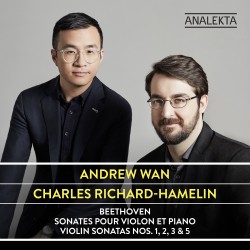 The ongoing Analekta series of the complete Beethoven Violin Sonatas with violinist Andrew Wan and pianist Charles Richard-Hamelin continues with the second volume, this time featuring the three Op.12 Sonatas – No.1 in D Major, No.2 in A Major and No.3 in E-flat Major – and the “Spring” Sonata, No.5 in F Major Op.24 (AN 2 8795 analekta.com). Volume One was reviewed here in December 2018.
The ongoing Analekta series of the complete Beethoven Violin Sonatas with violinist Andrew Wan and pianist Charles Richard-Hamelin continues with the second volume, this time featuring the three Op.12 Sonatas – No.1 in D Major, No.2 in A Major and No.3 in E-flat Major – and the “Spring” Sonata, No.5 in F Major Op.24 (AN 2 8795 analekta.com). Volume One was reviewed here in December 2018.
The Op.12 sonatas from 1797/98 were the first to be written and show the two instruments on an equal footing despite the customary “piano and violin” designation. They are joyful works – only one movement is in a minor key – and, while formally conventional, are imaginative and bright in texture. A pure delight from start to finish, the performances here are of the same high standard as on the earlier volume of a series that continues to impress.
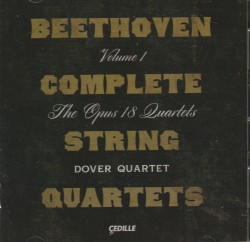 The Dover Quartet swept the board at the 2013 Banff International String Quartet Competition, the first prize announcement noting that they “consistently demonstrated an exceptional level of maturity, poise and artistry.” Add five or six years of performance experience to that judgement and you will have a good idea of the exceptionally high standard of their new release (2CDs priced as a single) Beethoven Complete String Quartets Volume 1 The Opus 18 Quartets (Cedille CDR 90000 198 naxosdirect.com/search/cdr+198).
The Dover Quartet swept the board at the 2013 Banff International String Quartet Competition, the first prize announcement noting that they “consistently demonstrated an exceptional level of maturity, poise and artistry.” Add five or six years of performance experience to that judgement and you will have a good idea of the exceptionally high standard of their new release (2CDs priced as a single) Beethoven Complete String Quartets Volume 1 The Opus 18 Quartets (Cedille CDR 90000 198 naxosdirect.com/search/cdr+198).
The Dover Quartet has performed the complete Beethoven quartet cycle in recital several times, the Montreal Chamber Music Festival performances being reviewed as a “musically transformative” event. The players have waited until they felt completely comfortable with their interpretations before committing them to disc, the recordings here being made in late 2018 and late 2019.
Although influenced by Haydn and Mozart, the Op.18 quartets show Beethoven clearly moving forward on his own path. The Dover members refer to them as playful and conversational and full of dramatic contrasts of mood and character, qualities which all shine through in performances of conviction and depth. This promises to be an outstanding set.
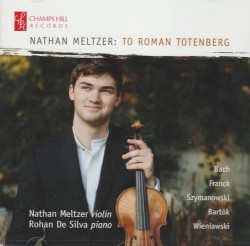 There’s a fascinating story behind Nathan Meltzer: To Roman Totenberg, the debut CD by the 20-year-old Austrian violinist, who has studied at Juilliard since he was 13, and pianist Rohan De Silva (Champs Hill Records CHRCD161 nathanmeltzer.com/cds). Totenberg’s 1734 Ames Stradivarius violin was stolen after his 1980 recital at the Longy School of Music in Cambridge, Massachusetts and was not recovered until 2015, three years after Totenberg’s death at 101. Professionally restored and consequently sold by Totenberg’s daughters, the violin has been on loan to Meltzer since October 2018.
There’s a fascinating story behind Nathan Meltzer: To Roman Totenberg, the debut CD by the 20-year-old Austrian violinist, who has studied at Juilliard since he was 13, and pianist Rohan De Silva (Champs Hill Records CHRCD161 nathanmeltzer.com/cds). Totenberg’s 1734 Ames Stradivarius violin was stolen after his 1980 recital at the Longy School of Music in Cambridge, Massachusetts and was not recovered until 2015, three years after Totenberg’s death at 101. Professionally restored and consequently sold by Totenberg’s daughters, the violin has been on loan to Meltzer since October 2018.
All the music on this CD was performed by Meltzer at a “Homecoming” concert at that same Longy School in November 2019, with Totenberg’s three daughters present. The pieces were all favourites of Totenberg, who recorded two of them – the Franck and the Bartók – on this very violin. It’s certainly a glorious instrument. Meltzer describes it as dark and resonant with a warm tone in every register, but there’s also a real brilliance in the high register.
Ably supported by De Silva, Meltzer is quite superb in a program that includes Bach’s violin and keyboard Sonata No.3 in E Major BWV1016, Franck’s Sonata in A Major, Szymanowski’s La Fontaine d’Arethuse from his Mythes Op.30, Bartók’s Rhapsody No.1 and Wieniawski’s Polonaise de Concert in D Major Op.4.
It’s an outstanding debut recording from a prodigiously talented player with an admirable sense of history.
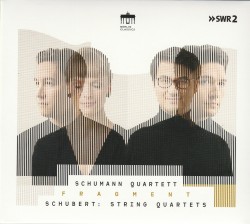 Fragment, the new Schumann Quartet CD of music by Franz Schubert, is part of their return to regular activity after the coronavirus hiatus, the ensemble having already played several concerts in July and August (Berlin Classics 030141OBC schumannquartett.de/eng/discography).
Fragment, the new Schumann Quartet CD of music by Franz Schubert, is part of their return to regular activity after the coronavirus hiatus, the ensemble having already played several concerts in July and August (Berlin Classics 030141OBC schumannquartett.de/eng/discography).
The three quartets here were chosen to show how Schubert evolved over the years, with failure a part of that development. The String Quartet No.6 D74 from 1813, when Schubert was just 16, shows a composer trying to find his own style. What was intended to become the String Quartet No.2 in C Minor in 1820 was apparently abandoned and is now known as the Quartettsatz D703, an Allegro assai first movement followed by an Andante fragment in which the first violin simply fades away after 40 bars. It is included here, giving the CD its title, and the final notes and ensuing silence seem to lead perfectly into the start of the String Quartet No.13 D804, the “Rosamunde,” a large-scale work that reflected Schubert’s approach to the symphony by way of chamber music.
Performances throughout are quite superb, with a lovely balance that allows all voices to be clearly heard, outstanding ensemble work, terrific dynamics and an obvious emotional connection with the music.
In 1938 the Austrian composer Eric Zeisl (1905-59) fled Vienna for Paris, where he was befriended by Darius Milhaud. Milhaud helped Zeisl’s family move to Paris and subsequently to Los Angeles in 1939, Milhaud himself following to Oakland, California in 1940. The two remained close friends.
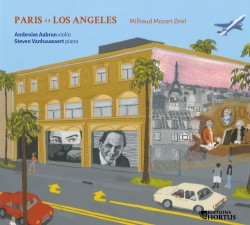 The French violinist Ambroise Aubrun discovered Zeisl’s music during his doctoral research at the University of California in Los Angeles, and his new album Paris <> Los Angeles with pianist Steven Vanhauwaert depicts the composers’ friendship as well as revisiting a Mozart sonata that apparently fascinated Zeisl (Editions Hortus 189 ambroiseaubrun.com).
The French violinist Ambroise Aubrun discovered Zeisl’s music during his doctoral research at the University of California in Los Angeles, and his new album Paris <> Los Angeles with pianist Steven Vanhauwaert depicts the composers’ friendship as well as revisiting a Mozart sonata that apparently fascinated Zeisl (Editions Hortus 189 ambroiseaubrun.com).
Two short pieces by Zeisl open and close the disc: Menuchim’s Song (1939) from the incomplete opera Job and the world-premiere recording of the lyrical Zigeunerweise, the first movement from the unpublished 1919 Suite for Violin and Piano Op.2 that Aubrun discovered in the Zeisl Collection at the university. The other Zeisl work is his substantial three-movement Brandeis Sonata from 1949, named for the California Institute where Zeisl was composer-in-residence.
Milhaud is represented by his four-movement Violin Sonata No.2 from 1917, a quite lovely work. The Mozart is the Violin Sonata No.21 in E Minor K304. Written in 1778 during the Paris visit that saw the death of his mother, it is his only minor key violin sonata as well as his only instrumental work in that key.
There’s excellent playing throughout a terrific CD, with the Mozart in particular a beautifully judged reading – clean and nuanced, with a finely balanced emotional sensitivity.
Listen to 'Paris <> Los Angeles' Now in the Listening Room
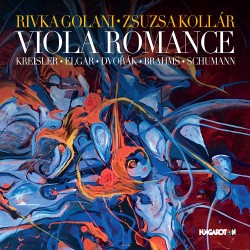 Viola Romance is the new 2CD set from violist Rivka Golani, accompanied by pianist Zsuzsa Kollár. It’s a collection of 35 transcriptions of works originally for violin and piano, mostly arranged and revised for viola and piano by Golani (Hungaroton 32811-12 hungarotonmusic.com).
Viola Romance is the new 2CD set from violist Rivka Golani, accompanied by pianist Zsuzsa Kollár. It’s a collection of 35 transcriptions of works originally for violin and piano, mostly arranged and revised for viola and piano by Golani (Hungaroton 32811-12 hungarotonmusic.com).
Fritz Kreisler and Edward Elgar dominate CD1, with nine Kreisler originals and four Kreisler arrangements of single pieces by Chaminade, Granados, Tchaikovsky and Gluck. Eight Elgar tracks complete the disc.
Kreisler’s presence is also felt on CD2 with six arrangements: five pieces by Dvořák to open and Eduard Gärtner’s Aus Wien as the final track. In between are three pieces by František Drdla, two Brahms/Joachim Hungarian Dances, Jenö Hubay’s Bolero and two Leopold Auer transcriptions of works by Robert Schumann.
The Kreisler influence is no accident, the interpretations here having been inspired by Golani’s collaboration with Kreisler’s longtime accompanist Franz Rupp, who died in 1992; his final performance was with Golani in 1985.
Most of these short pieces (27 are under four minutes) are well-suited to the darker tone of the viola, although Golani’s generally wide and fairly slow vibrato tends to reduce the warmth at times. Still, as you would expect, there’s much fine playing here.
Listen to 'Viola Romance' Now in the Listening Room
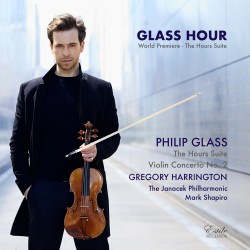 The New York-based Irish violinist Gregory Harrington founded the Estile Records label in 2006 (gregoryharrington.com), and has built a reputation for successfully transforming movie scores, jazz, rock and pop music into brand new violin concert pieces. His new CD Glass Hour with the Janáček Philharmonic under Mark Shapiro features music by Philip Glass, including the world-premiere recording of Harrington’s The Hours Suite, his own attractive arrangement of music from the 2002 Oscar-nominated Glass score for the movie The Hours. The three movements – Morning Passages, The Poet Acts and The Hours – were respectively tracks 2, 1 and 14 on the soundtrack album, and as the timings are almost identical they would appear to be straight transcriptions.
The New York-based Irish violinist Gregory Harrington founded the Estile Records label in 2006 (gregoryharrington.com), and has built a reputation for successfully transforming movie scores, jazz, rock and pop music into brand new violin concert pieces. His new CD Glass Hour with the Janáček Philharmonic under Mark Shapiro features music by Philip Glass, including the world-premiere recording of Harrington’s The Hours Suite, his own attractive arrangement of music from the 2002 Oscar-nominated Glass score for the movie The Hours. The three movements – Morning Passages, The Poet Acts and The Hours – were respectively tracks 2, 1 and 14 on the soundtrack album, and as the timings are almost identical they would appear to be straight transcriptions.
Glass’ Violin Concerto No.2 “American Four Seasons,” scored for strings and synthesizer, is the other work on the CD. Glass left the four movements untitled, with a solo Prologue and three numbered Songs between the movements acting as violin cadenzas. There’s a lovely feel to the slower sections in particular, although there are one or two moments in the fast perpetual motion passages where the intonation feels a bit insecure.



